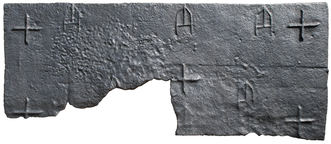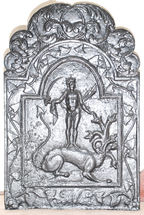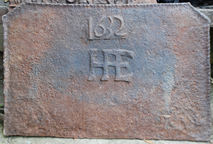-
797
Description: Rectangular; twisted rope edging (top and sides); three impressions of an ornate firedog, each incorporating lion’s legs, above it a pedestal with a lion’s head, surmounted by a caryatid, a shield shaped cartouche over its lower trunk, and with a floral vase headdress. The dog impressions are not evenly stamped, the middle one lying to the right.
Notes: The firedogs are much more elaborate than those customarily used as stamps on firebacks and indicate a later date; they probably included brass elements and were possibly French.
- Decoration tags:
- rectangular (shape)
- rope (edging)
- simple stamps
- objects
Manufactured: in the late-16th to early-17th century in the Weald area of England.
Current location: in private hands, Wisborough Green, West Sussex, England.
- Attached to series:
- Firedog stamp firebacks
- Metalware stamp firebacks
-
802
Description: Arched rectangular shaped; astragal edging (top and sides); mainly symmetrical vine arrangement, emerging from a vase, some fronds ending in an eagle’s head, other in leaves; at top of arch, initials ‘HB’ split by date (reversed) with an additional ‘I’; below, initials ‘AIS’ (reversed).
Notes: Two planklines; ‘HB’ refers to Henry Bell, who acquired Rake Manor, Witley, in 1592. ‘AIS’ refers to Anthony Smith, his nephew and heir, and his wife, Joan (née Hore); the form of the date is confused by the addition of an ‘I’, and the somewhat clumsy arrangement of the inscription suggests that it was added to the otherwise foliate pattern priot to casting. The letter 'H' seems to belong to a different character set
Copies of this fireback are known.
Inscription: H I0361B / AIS
- Decoration tags:
- rectangular with round arch (shape)
- astragal (edging)
- whole carved pattern
- planklines
- pictorial
- text
- plants
Manufactured: in 1630 possibly at Witley Park Furnace in the Weald area of England.
Current location: Rake Manor, Witley, Surrey, England.
Citation: Giuseppi, M. S., 1903, 'Rake in Witley [etc.]', Surrey Archaeological Collections, 18, pp. 11-60.
- Attached to series:
- Personal firebacks
- Miscellaneous pattern firebacks
-
636
Description: Rectangular; no edging; quasi-symmetrical arrangement of crosses and buckle outlines: a cross at each corner and one to right of middle, three buckles along the top and three buckles in triad, level with, and below, the central cross; two horizontal plank lines; lower left part of back missing due to wear and corrosion. The fireback has a small accumulation of iron slag on the reverse side, probably caused by a failure, by the founder, to tap off all the slag from the furnace hearth before casting.
Notes: The buckles, which could have been stamped using a branding iron, suggest a connection with the Pelham family. This is the fireback noted in 1861 at Warbleton Priory, Sussex, which the Pelhams endowed in 1413; the priory was dissolved in 1535 suggesting that the fireback dates from before then. The excrescence, left of centre, on the surface of the fireback was probably caused by molten iron being poured from a ladle into the sand mould and displacing some of the sand.
- Decoration tags:
- rectangular (shape)
- none (edging)
- simple stamps
- carved stamps
- planklines
- heraldic
- objects
Manufactured: in the early- to mid-16th century in the Weald area of England.
Current location: Anne of Cleves House, Southover High Street, Lewes, East Sussex, England.
(part of the Sussex Archaeological Society museum group)
- Attached to series:
- Pelham family firebacks
- Metalware stamp firebacks
-
803
Description: Arched rectangular central panel, astragal and fillet edge, pictorial, Hercules, sword in hand, preparing to slay the Hydra; Arched rectangular border, fillet edge, ivy leaves and tendrils, monogram at bottom; swirled foliage on top.
Notes: The wooden pattern for this fireback (no. 927), formerly in the custody of William Hobday (d. 1883), last surviving ironworker at Ashburnham furnace, was given to the Sussex Archaeological Society by the Revd. J. Bickersteth. The fireback was previously at a house at Hooe, East Sussex.
Copies of this fireback are known.
Inscription: TAN
- Decoration tags:
- 'Dutch' (shape)
- fillet (edging)
- whole carved pattern
- pictorial
- mythological
- monogram
- text
- humans
Manufactured: in the 18th century at Ashburnham Furnace in the Weald area of England.
Current location: in private hands, Crawley, West Sussex, England.
Citation: Butterfield, W. R., 1916, 'Old Wealden Firebacks', The Connoisseur, 46, pp. 197-209.
Citation: Lloyd, N., 1925, 'Domestic Ironwork I', Architectural Review, 58, pp. 58-67.
Citation: Straker, E., 1931, Wealden Iron (London, Bell).
- Attached to series:
- TAN series
- British 'Dutch' style firebacks
-
254
Description: Curved ogee-arched rectangular with egg and dart moulding along top, supported by Ionic pilasters; English Stuart royal shield, garter, helm, crown, motto and supporters; date below and either side of garter.
Notes: One of several firebacks, all of the same date, but varying in size, framing style and moulding; all have stylistic features in common and will have been the work of the same pattern maker, who was also responsible for carving royal coats of arms in three West Country churches. A casting of this design serves as a royal armorial in St Lawrence's church, Bigbury, Devon.
Copies of this fireback are known.
Inscription: HONI + SOIT + QVI + MAL + Y + PENSE / 16 18
Arms: English Stuart royal (James I)
- Decoration tags:
- rectangular with round arch (shape)
- complex individual (edging)
- whole carved pattern
- planklines
- armorial
- royal
- text
Manufactured: in 1618 possibly in the Forest of Dean area of England.
Current location: not known.
-
805
Description: Rectangular with canted top corners; twisted rope edging (top and sides); top centre, date formed from a single stamp, over-pressed; monogram below date.
Notes: Dates formed from a single stamp are uncommon, this series being distinguished by this practice.
Inscription: 1632 / HPE
- Decoration tags:
- rectangular with canted top corners (shape)
- rope (edging)
- carved stamps
- date stamp
- monogram
- text
Manufactured: in 1632 in the Weald area of England.
Current location: Yapton Metal Co., Yapton, West Sussex, England.
- Attached to series:
- 1630s HPE series





